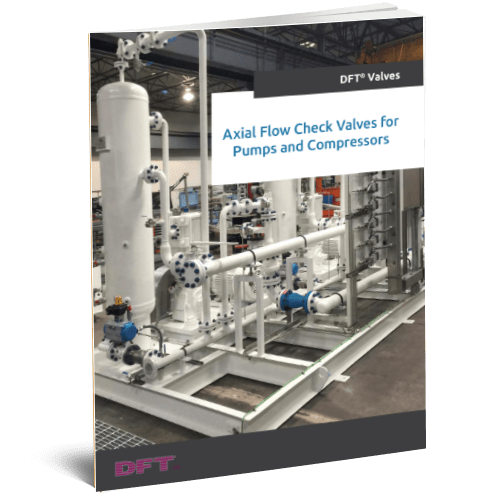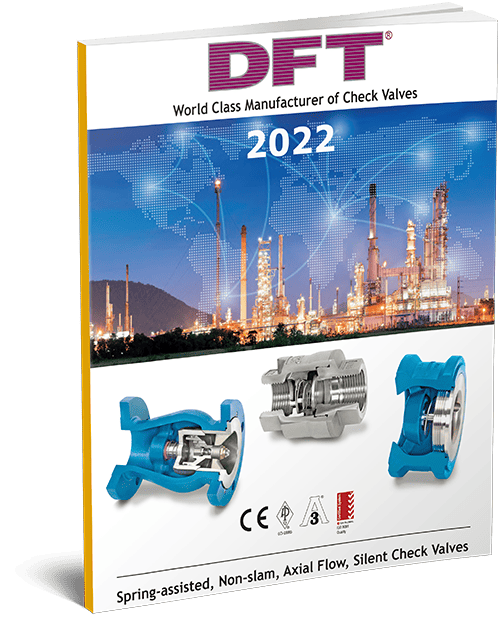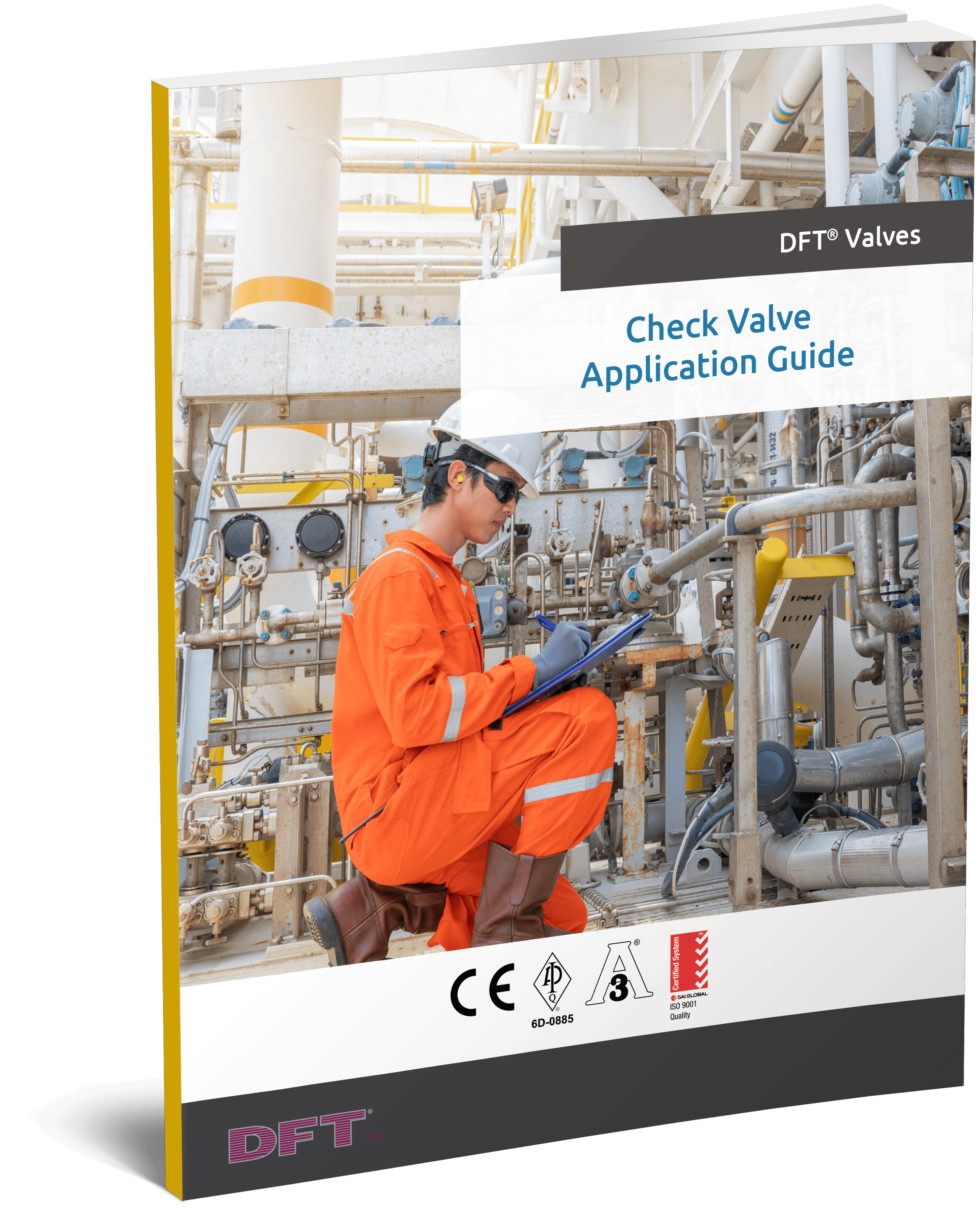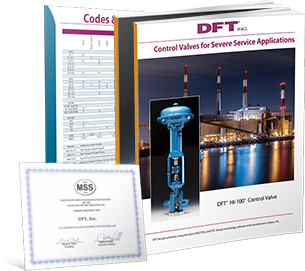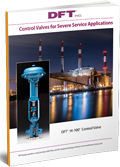Category Archive: Check Valves
Maintenance and Replacement Blog Series: SCV-R® Check Valves for High Cracking Pressure
At DFT® Inc., our SCV-R® Check Valves exemplify our commitment to providing products that can withstand the toughest environments, including applications with high cracking pressure. These products are fully comparable to their counterpart, the DFT® Model SCV®, but with enhanced features that allow them to endure high cracking pressure conditions—including a spring-assisted, non-slam design that reduces or eliminates water hammer.
An Ideal Solution for High Cracking Pressure Applications
Many advanced applications require check valves for high cracking pressure. Cracking pressure is the point at which the valve opens and the media is introduced to the system. Using a spring-assisted design, DFT® Model SCV-R® Check Valves are ideal for such advanced applications. With versatile, corrosion-resistant features, they are also cost-effective, making them a preferred option in a number of uses.
SCV-R® Check Valves Also Solve Water Hammer
Water hammer is another common problem affecting applications that require check valves, often signified by a loud hammering sound coming from pipes. The condition arises when valves either shut too quickly or pumps suddenly shut down, causing the moving water to backflow when encountering the closed valve.
This causes loud noises and potential damage to pipes. Fast-closing SCV-R® Check Valves help to eliminate this problem; for further details, download our eBook, “Understanding Water Hammer.”
A Wide Array of Advantages
The high-quality design and reliable materials of SCV-R® Check Valves provide a host of advantages, including:
- High versatility allows valves to be used in both vertical and horizontal installations.
- Easy maintenance helps to extend service life.
- Stainless steel construction provides the utmost strength and corrosion resistance—even in the harshest environments.
- Usability in many different applications, including hydraulic lines, boilers, pumps, and compressor discharge, makes the valves incredibly versatile.
SCV-R® Check Valves are also available with a full array of options, some of which include:
- 316 stainless steel springs
- A soft seat
- Hastelloy® or Alloy 20 body and seat material
- Repair and field conversion kits
Download the SCV-R® Cut Sheet for Details
To explore our full selection of durable, cost-effective SCV-R® Check Valves, download a free copy of the SCV-R® cut sheet. You will learn how these self-contained valves provide unparalleled reliability and service life for virtually any liquid, gas, or steam application.

Valve Basics Seminar Recap
Each year, the Valve Manufacturers Association of America (VMA) hosts a series of highly regarded Valve Basics Seminars & Exhibits to give industry associates — ranging from engineering students to experienced professionals looking to broaden their subject knowledge — a hands-on crash course in valves.
Last month’s three-day seminar hosted approximately 70 participants at the Embassy Suites Chicago O’Hare in Rosemont, IL. The dynamic program featured several speaker presentations highlighting different aspects of valves and valve safety, as well as the iconic Valve Petting Zoo, where attendees participated in hands-on demonstrations of what they’d learned earlier in the classroom.
Getting Hands-on with Valves
The Petting Zoo, a relatively new addition to Valves 101 developed based on past participant feedback, turned out to be the highlight of the program. On the second day of the seminar, after each speaker had an opportunity to present, they showcased their topics in action as attendees rotated around nine different stations to gain further understanding through hands-on learning.
“The valve petting zoo was outstanding,” said one attendee. “I learned a great deal by seeing how valves actually function and operate.”
Valves, Actuators & Controls 101 with DFT®
DFT®’s own Director of Sales and Marketing, Jeff Kane, and Regional Sales Manager, Bud Volz; have had the honor of presenting the Valve Basics Seminar & Exhibits for the past several years. This year, Kane’s course segment in “Valves, Actuators & Controls 101” focused on the subject of check valves, the importance of check valve sizing, and preventing water hammer.
In his presentation, Kane discussed how correctly sized check valves can minimize unnecessary costs by preventing low flow situations that lead to valve failure, as well as high velocity flows that can cause high-pressure shock waves (commonly known as water hammer. Students are given an unbiased presentation regarding the features and benefits of all the popular types of check valves.
Next Stop: Texas
Valves 101 will be stopping at the Sheraton Houston Brookhollow Hotel in Houston, Texas on October 18-20 for the next installment of the Valve Basics Seminar & Exhibits program. To date, over 1,500 people have attended these workshops; the VMA looks forward to expanding this number and continuing to spread the word on the importance of valves and valve safety.
To find out more about the next Valve Basics Seminar & Exhibits program and how to attend, visit the VMA.org website.
Learn more about check valves and how to avoid common sizing mistakes by downloading DFT’s free eBook, “Common Mistakes in Check Valve Sizing.”

Maintenance and Replacement Blog Series: Preventing Water Hammer with SCV® Check Valves
For more than 70 years, DFT® Inc. has focused on manufacturing dependable and high-quality check valves across all industries. We have a long history of solving valve problems and preventing failures, exemplified by our line of SCV® Check Valves.
Specially designed for tight shutoff, high cycling, and system protection from the effects of water hammer, these valves are relied on for a variety of liquid, gas, and steam applications. Equipped with corrosion-resistant features, SCV Valves are an economical and consistently dependable option.
Designed for Optimal Water Hammer Resistance
Water hammer is a persistent and potentially highly damaging problem that is found in all types of piping systems. It occurs when moving fluids are forced to suddenly stop; once stopped, the fluid’s momentum creates a pressure wave that flows throughout the closed pipe system.
The resulting pressure spikes can cause significant damage to domestic and industrial piping systems. However, this damaging phenomenon can be prevented using specialty products, such as SCV® Check Valves. For more information, download our water hammer eBook.
Advantages and Features of SCV® Check Valves
With simple yet rugged construction, SCV® Check Valves offer a full array of features:
- Protection from Water Hammer — This valve model was specifically designed to protect all types of applications from water hammer. It features a non-slam, spring-assisted design that provides a tight shutoff.
- Simple Design — The rugged valve construction consists of a body, seat, spring, edge-guided disc, and body seal, which is engineered to handle at least a million cycles.
- Best Quality Materials — Built to withstand the harshest industrial environments, SCV® Check Valves are constructed from the finest quality materials, including:
- ASTM A240 316 for the disc
- Inconel® X-7650 for the spring
- ASTM A351 CF8M for the seat and body
- Zelon® O-Ring for the seal, with optional seal-welded body joint that can handle temperatures up to 700°F
- Soft Seat, NPT, or Socket Weld Ends are available
- Options include 316SS springs, body seal weld, soft seat, Alloy 20 or Hastelloy C body & seat (ASME 300)
- All Sizes Available — SCV® Check Valves are available in sizes ranging from 1/3” to 3”
- Built to Handle Most Media — The valves handle 750 cold working pressure (CWP) and 3600 psi, providing tight shut off capabilities for gas, liquid, or steam
Choose SCV® Check Valves for Your Applications
Easy-maintenance check valves from DFT® are available for installation in both vertical and horizontal configurations. Customers in a wide range of industries, from mining and steam transmission to primary metals and power generation, rely on our check valves for many of their applications.
To learn more about the features of SCV® Check Valves, download our SCV® cut sheet. Additional information is available on our Threaded In-Line Check Valves catalog page or by contacting the DFT® team directly.
Maintenance & Replacement Valves Blog Series:
Vacuum Breakers and Their Applications
Valves play an integral part in many applications performed by anyone from a manufacturer to an engineer to a construction manager. The basic function of a valve is to control both the flow and pressure within a process or system. The functions of a valve include:
- Regulating a flow or process pressure
- Relieving a system of pressure
- Stopping or starting a flow
- Increasing or reducing a flow
- Controlling the flow’s direction
 Keeping this in mind, a Vacuum Breaker Check Valve provides effective protection against collapse of pressure vessels, tanks and piping. This particular valve prevents condensate “back-up” when equipment is shut down or inlet steam is reduced by modulating control valves. Within a piping system, DFT® Vacuum Breakers can perform helpful tasks, such as:
Keeping this in mind, a Vacuum Breaker Check Valve provides effective protection against collapse of pressure vessels, tanks and piping. This particular valve prevents condensate “back-up” when equipment is shut down or inlet steam is reduced by modulating control valves. Within a piping system, DFT® Vacuum Breakers can perform helpful tasks, such as:
- Breaking a siphon
- Preventing pipe collapse during transient pressure drops
- Providing additional air on downstream side of check valves to help prevent water hammer
This variation of a check valve, or Vacuum Breaker, features a spring-assisted silent closure. If there is no pressure on the valve, the spring pushes the disc into a closed position. Other features include:
- 1” to 4” size range (MNPT)
- 450 to 6000 CWP
- Threaded O.D. with unthreaded inlet bore
- Stainless steel construction
- Horizontal or vertical installation
- Tight shutoff – lapped disc and seat
- Inconel X-750 Spring
- soft seat options
The wide variety of DFT® Vacuum Breakers makes it easy to find and install the one that’s correct for any application. Beyond their use in building water systems, they can be used in anything from chemical processing to power generation to pharmaceutical applications.
With so many applications requiring a strict no-backflow function, we’ve compiled a list of codes and standards, as well as industry applications into a downloadable catalog. Select the button below to download our free eBook, Vacuum Breaker Check Valves: Your Defense Against Pipe Collapse & Pressure Vessel Damage.

10 Things Engineers & Maintenance Managers Should Know About Check Valves
Check valves serve a wide variety of purposes and services. Understanding how they work is essential to accessing the range of benefits they offer. We all want to purchase check valves that are not only of the highest quality, but offer long-lasting durability and sustainability. Finding the best valve for your project requires research and a clear understanding of the way the valves work and how they will impact your application. To ensure that your valves run smoothly from start to finish, there are key facts about check valves that all engineers and maintenance managers must know.
Below is DFT’s list of the top ten things to keep in mind when purchasing and implementing check valves.
- Check Valves are an essential element in the design of an efficient pumping system
- Check Valves should be sized for their application and flow, not based just on pipe diameter
- Water Hammer is a direct result of a pressure surge or wave caused when a fluid (usually a liquid or slurry ) in motion is forced to stop or change direction suddenly
- Water Hammer can be significantly reduced with the correct choice of Check Valve
- An undersized valve will cause high pressure losses and create excessive noise and vibration
- An oversized valve can lead to premature wear and failure of the valves internal components
- Properly sized check valves can dramatically add to the life of the valves as well as longevity of pumps and other related components
- An energy efficient check valve is a properly sized check valve in a pump fluid flow system that allows the required flow, while minimizing energy consumption
- Low flow application check valves should be sized so the valve is fully open based on maximum flow
- Metal sealing surfaces generally will allow some leakage while elastomers (soft seats) such as Buna-N and Viton provide bubble-tight shutoff (zero leakage)
When used properly and for the appropriate projects, check valves can offer consumers a wide range of useful benefits. Understanding their capabilities, then, proves an essential part of utilizing them toward the success of your system. To find out other key considerations when designing fluid or Gas flow Systems, download our Design for Flexibility eBook.
At DFT Valves, we’re committed to providing you with exemplary valves for a wide range of systems and services, if you have questions, please contact us today.






